Water brings life to the desert for the native plants, wildlife and people too. In fact only 100 years ago the arid landscape we now call Joshua Tree National Park saw more precipitation and the hidden springs of oasis filled with palms provided a perfect place to live. Plus miners and ranchers once built structures like Barker Dam to hold back the life giving water.
I hope you’re not tired of seeing the boulders in Joshua Tree because I did one more walk on my last full day in the park.
After Keys View looking down on the Coachella Valley full of the congestion of too much civilization in one place I really needed a nature fix. So after some lunch with temperatures rising enough to reduce one layer I headed for the nature walk on the Barker Dam trail.
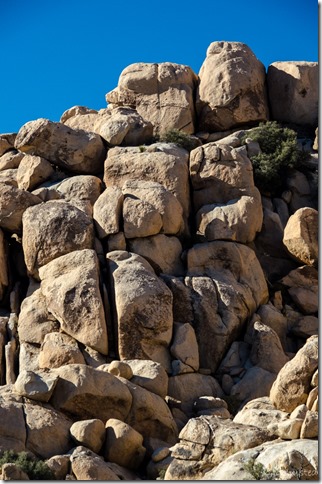 I never tire of seeing the boulders which look stacked by giants.
I never tire of seeing the boulders which look stacked by giants.
 They seem to call for rock climbing and although this one isn’t as big as some it may be a good way to learn without being so far from the ground.
They seem to call for rock climbing and although this one isn’t as big as some it may be a good way to learn without being so far from the ground.
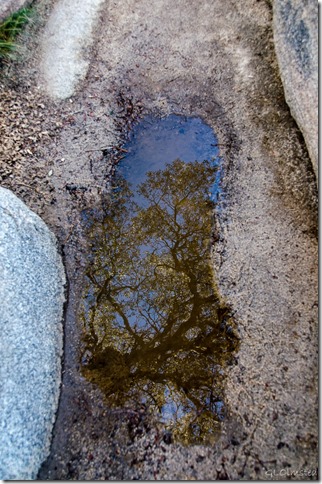 I figured with the recent rain Barker Dam would be full of water enticing some wildlife into the area. There were a a few puddles along the trail.
I figured with the recent rain Barker Dam would be full of water enticing some wildlife into the area. There were a a few puddles along the trail.
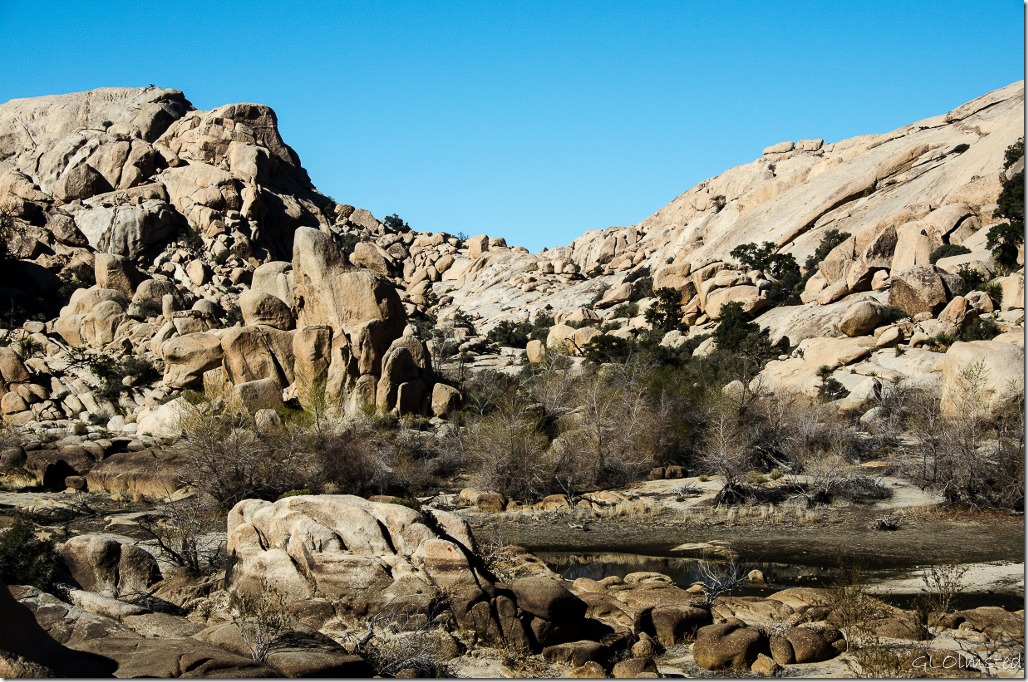 Yet there was very little water behind the dam which looked more like a mud puddle. Notice the water lines on the surrounding rocks that tell a different story of water levels.
Yet there was very little water behind the dam which looked more like a mud puddle. Notice the water lines on the surrounding rocks that tell a different story of water levels.
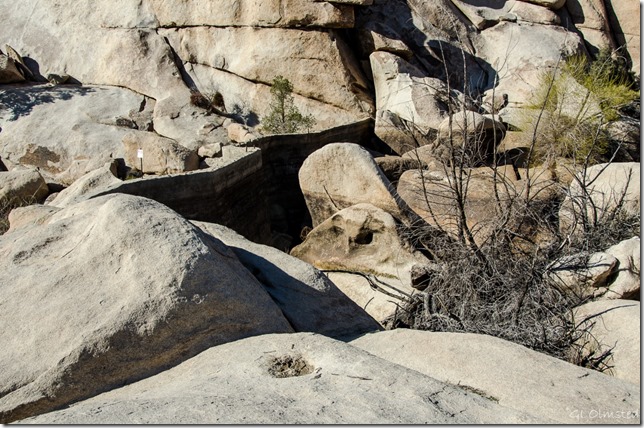 According to the interpretive signs, what started as a natural catch basin for rainfall and runoff was blocked by the Barker Dam, originally built by the Barker & Shay Cattle Company in 1902 when an average of 10 inches (.25 m) of annual rain fell here compared to the 2-5 inches (.05-.12 m) now. Grasses were lush for grazing.
According to the interpretive signs, what started as a natural catch basin for rainfall and runoff was blocked by the Barker Dam, originally built by the Barker & Shay Cattle Company in 1902 when an average of 10 inches (.25 m) of annual rain fell here compared to the 2-5 inches (.05-.12 m) now. Grasses were lush for grazing.
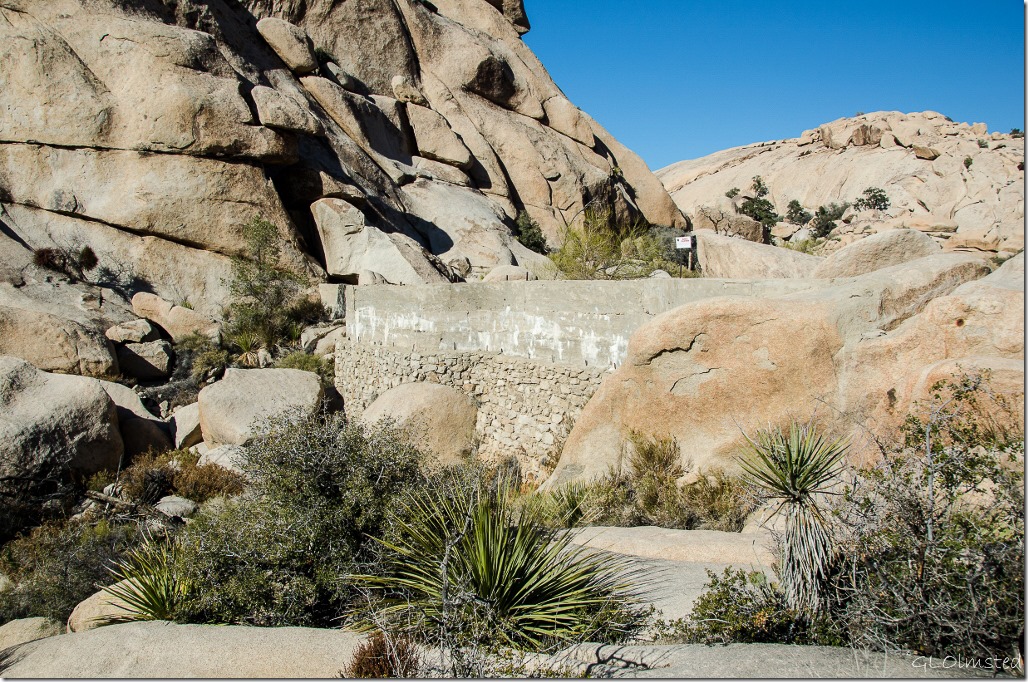 Then between 1940-50, rancher Bill Keys and family added the upper concrete layer on top of the lower stone wall. I really wanted to take the Ranger-guided Keys Ranch tour to see and learn more about this hardy family that survived 60 years in this desert. Unfortunately, the first available reservations were for two weeks away.
Then between 1940-50, rancher Bill Keys and family added the upper concrete layer on top of the lower stone wall. I really wanted to take the Ranger-guided Keys Ranch tour to see and learn more about this hardy family that survived 60 years in this desert. Unfortunately, the first available reservations were for two weeks away.
 Over the years of low water many have left their mark on the accessible dam wall. What is wrong with people who feel the need to mar our park’s natural or cultural history? Does it become part of the story?
Over the years of low water many have left their mark on the accessible dam wall. What is wrong with people who feel the need to mar our park’s natural or cultural history? Does it become part of the story?
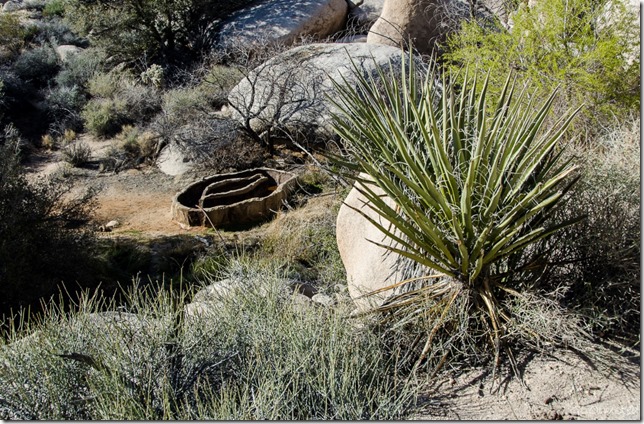 At its maximum the water encompasses about 20 acres (8 ha) with a pipeline carrying water to the cattle trough in the wash behind the dam. Non-native plants like willows were planted to provide shade for the cattle and in wet years cattails can be seen. Whatever little moisture is here attracts many animals and birds. Coots and grebes are known to nest here and migrating herons stop by.
At its maximum the water encompasses about 20 acres (8 ha) with a pipeline carrying water to the cattle trough in the wash behind the dam. Non-native plants like willows were planted to provide shade for the cattle and in wet years cattails can be seen. Whatever little moisture is here attracts many animals and birds. Coots and grebes are known to nest here and migrating herons stop by.
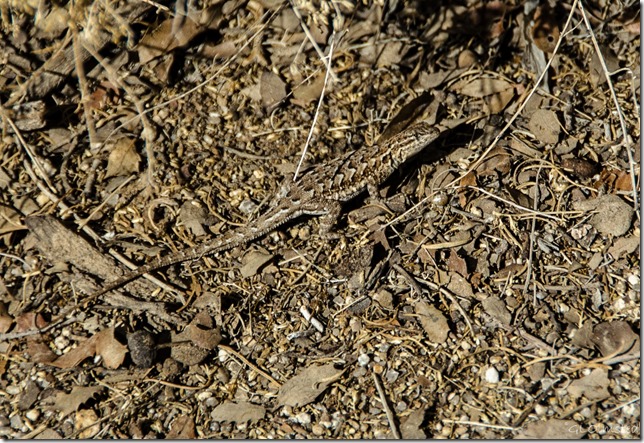 Unfortunately my mid-day walk meant most smart desert dwellers were hiding in the shade.
Unfortunately my mid-day walk meant most smart desert dwellers were hiding in the shade.
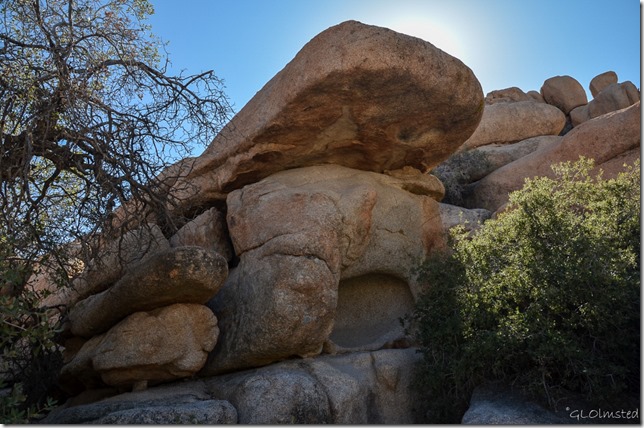 I continued walking the loop, up, over and around the boulders, occasionally seeking a shady rest. I certainly wasn’t tired, yet I wanted to be in touch with the rock, to listen to their stories.
I continued walking the loop, up, over and around the boulders, occasionally seeking a shady rest. I certainly wasn’t tired, yet I wanted to be in touch with the rock, to listen to their stories.
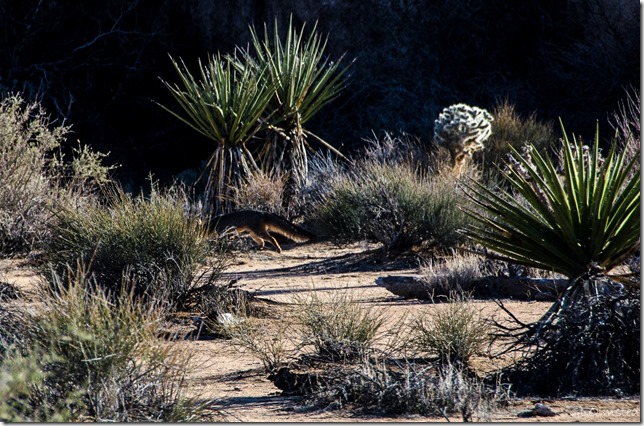 Gray fox slips through the brush
Gray fox slips through the brush
Then I moved on, like the miners, ranchers and visitors before me while the true Mojave desert survivors remain, adjusting to diminishing water. Times will change again for us humans and we would be wise to learn from other life how to adapt.
 People before us, bands of the Chemehuevi, Serrano, and Cahuilla Indians, laid out their trails between water holes, gathered plants for food and textiles, and left their marks behind.
People before us, bands of the Chemehuevi, Serrano, and Cahuilla Indians, laid out their trails between water holes, gathered plants for food and textiles, and left their marks behind.
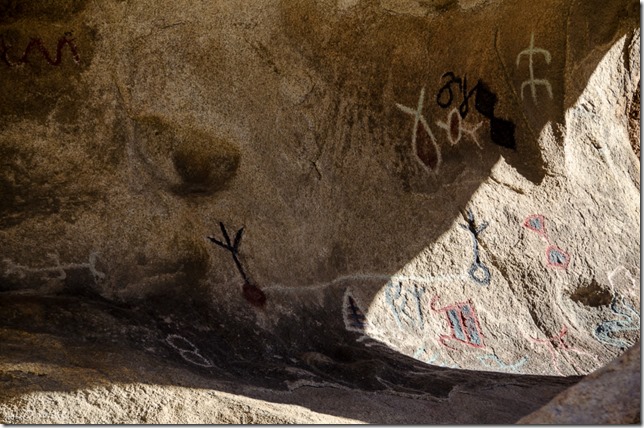 Sadly the rock art has been defaced. Rumor has it that decades ago a film company painted these so they could be seen more clearly. Presumably we didn’t know any better then. Ahem.
Sadly the rock art has been defaced. Rumor has it that decades ago a film company painted these so they could be seen more clearly. Presumably we didn’t know any better then. Ahem.
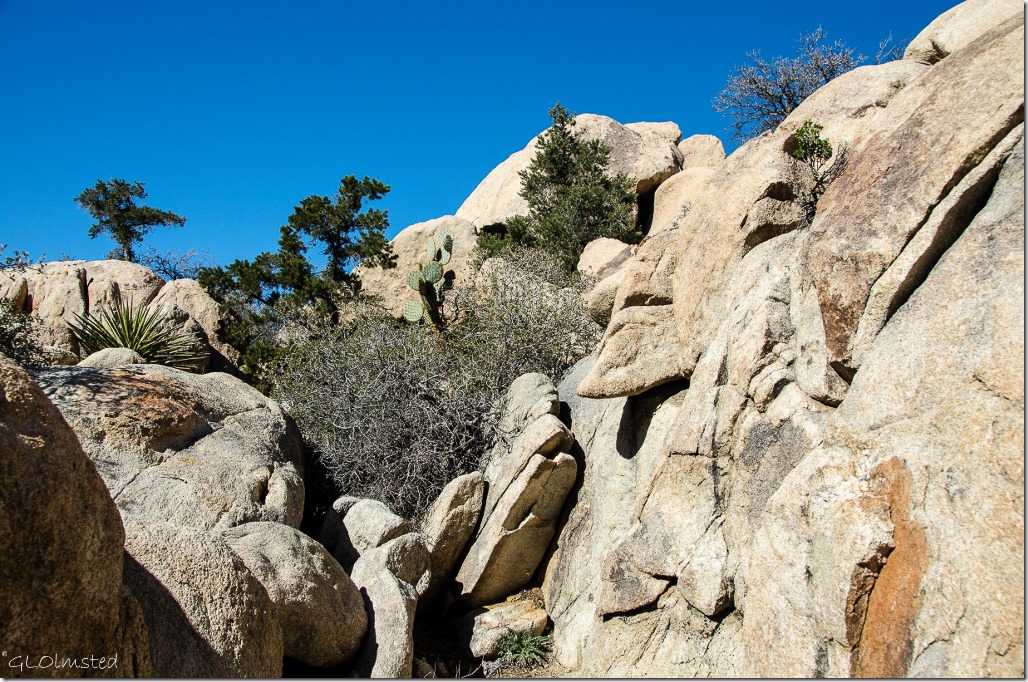 This easy 1.3 mile (2 km) loop past Barker Dam with a few short rock scrambles took me a couple of lollygag hours as I paused to look at the way life survives in this arid environment even with the occasional help of water. And speaking of water, I carried two liters finishing both even on a cool spring afternoon. Think about the dry excessive heat of a summer walk and be prepared.
This easy 1.3 mile (2 km) loop past Barker Dam with a few short rock scrambles took me a couple of lollygag hours as I paused to look at the way life survives in this arid environment even with the occasional help of water. And speaking of water, I carried two liters finishing both even on a cool spring afternoon. Think about the dry excessive heat of a summer walk and be prepared.

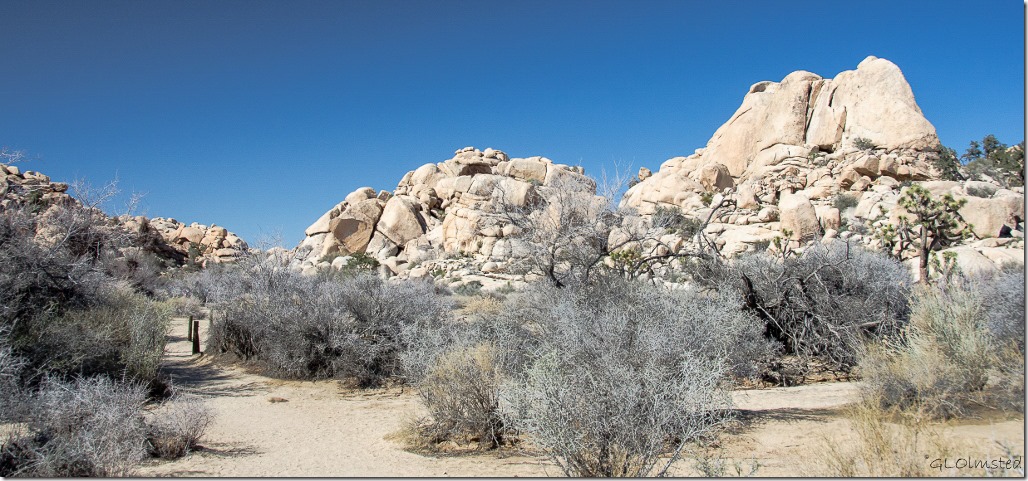
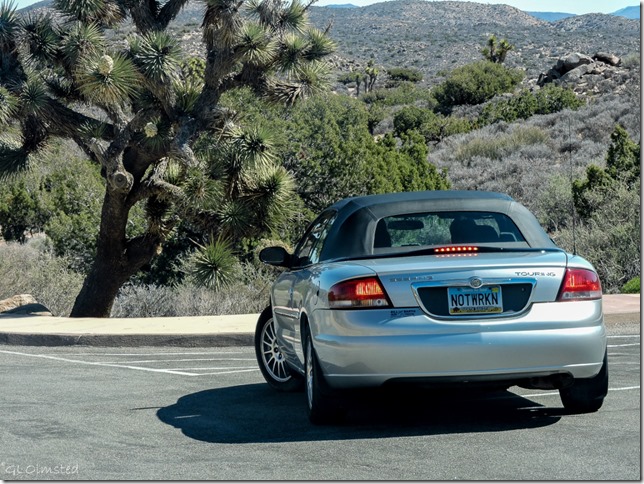
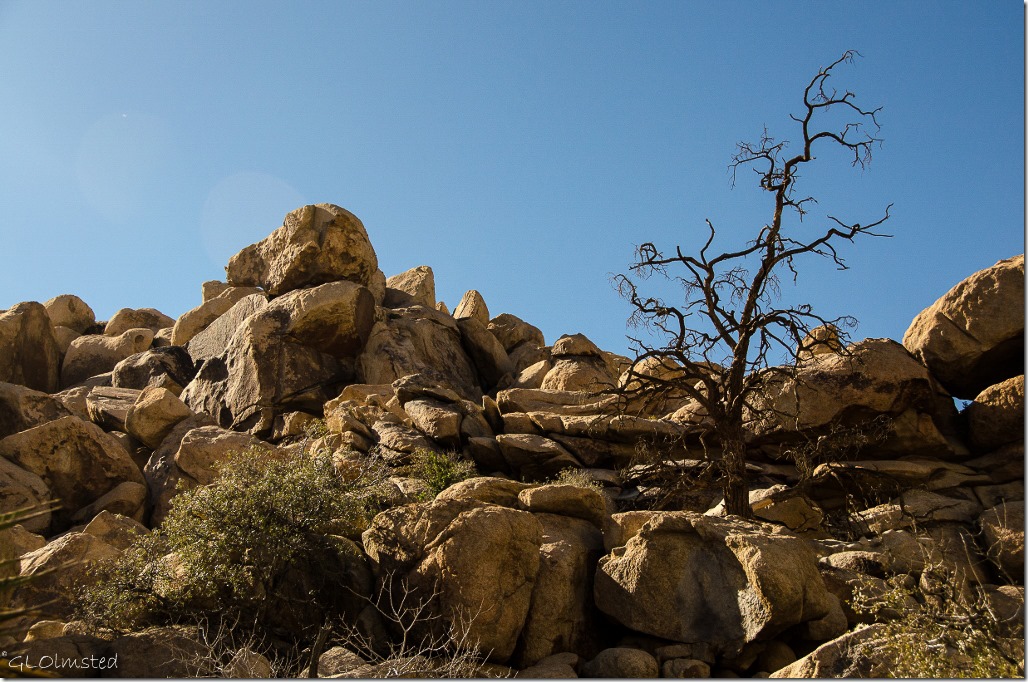
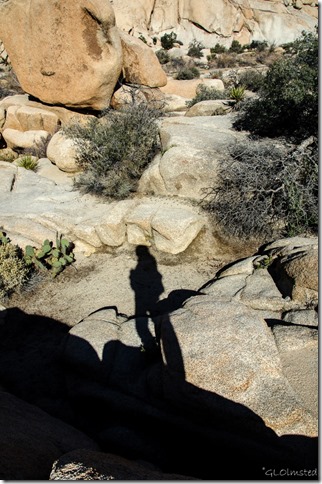
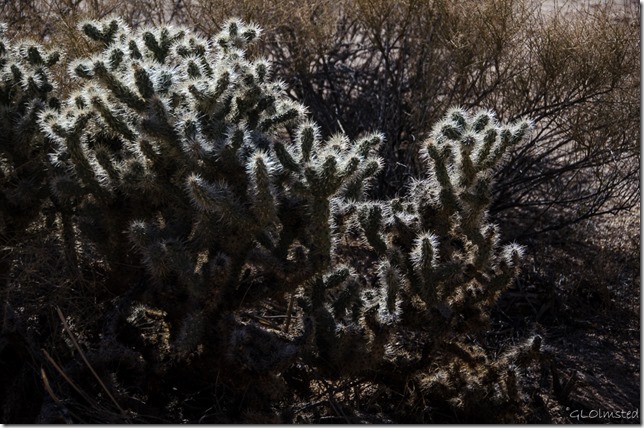
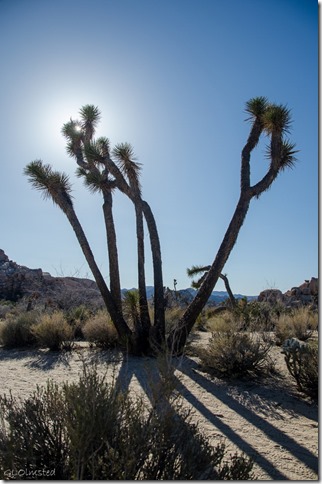
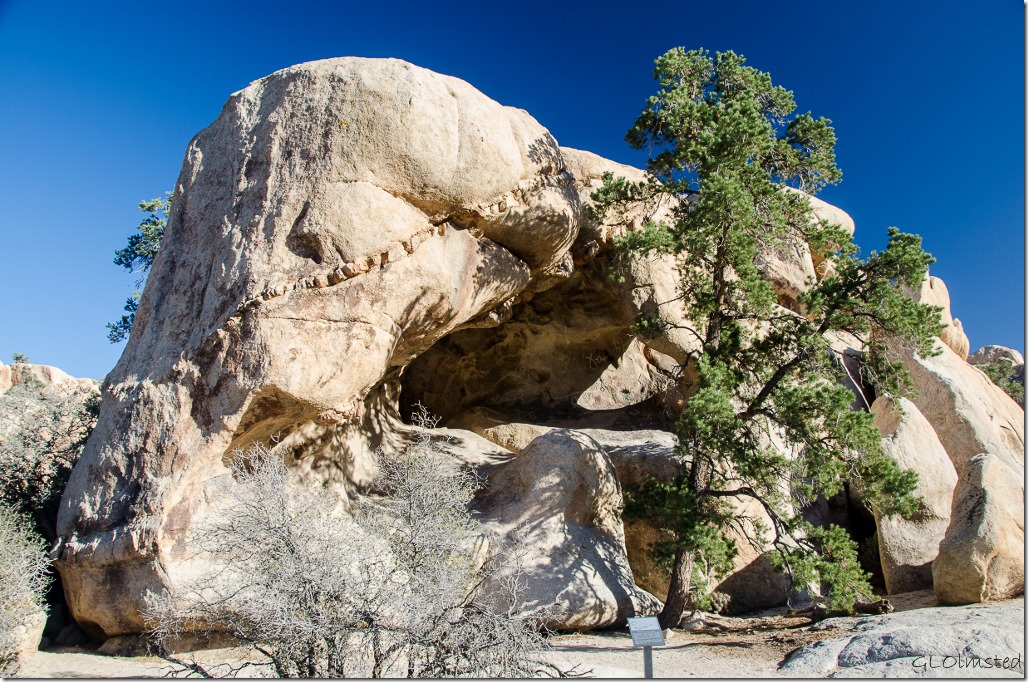
Great tour. Amazing how people survived in such harsh climates.
Also bewildering why people want to deface sites. Somebody went on a spray paint spree at Turkey Mountain and now everybody is wondering what is a good way of removing the mess.
Thanks Yogi, us humans are survivors.
That’s disgusting that someone sprayed on Turkey Mt. You all are fighting so hard to keep the place pristine and natural. I am always impressed when the groups go out and pick up all the junk and trash. Hope you’re still fighting against that mall too.
Awesome scenes and images from the park! It is a gorgeous place to visit..
Happy to take you along Eileen.
That was great! I love all the stacked rocks too. Went to Joshua Tree for a rock climbing school years ago and would love to go back!
Thanks. Joshua Tree is certainly a good place to learn to climb. I’d have done it years ago but now my shoulders are shot. Hope you get to return.
We took 3 classes of 3rd graders there last year. Our school got some kind of grant, which has now disappeared. The grant even paid for the buses! On our way back around the loop, we saw a young kingsnake and the kids were all excited! And, at that time, there WAS water in the dam. So sad that it is so low now…So glad you got to see the fox. Once in a while, I see one that has been hit by a car up on Highway 74…sigh…
School field trips are almost a thing of the past but glad the grant got some kids into the park. Plus how exciting to see a Kingsnake. I saw a rosy boa the first time I visited years ago, when there was water in the dam. The fox was exciting until another visitor/photographer rather chased it away.
I can’t seem to get tired of these places.
Love the car’s numberplate
And lastly, people doing graffiti at natural sites like that really irks me as well. Actually more than irk.
So glad you are enjoying our SW desert landscapes Jonker. That license plate was just to good to pass up. I’ll never understand deliberate destruction on anything.
Never tire of looking at rocks. Enjoyed your photos as always.
Thanks. Me either.
Absolutely loved this walk ‘with’ you! Never tired of photos like these – keep ’em coming!
Thanks for coming along Jackie.
I love rocks and I love the soft rounded look of these–weathered by the ages. Should the dam be removed? Thanks for all the pics. Humans can be maddenings can’t they.
MB
I think it’s questionable whether the dam should be removed. It’s part of the cultural story at Joshua Tree. I do hate seeing all the writing on the dam, but better there than the boulders.
Fascinating place! I have enjoyed Ansel Adams pics of Joshia tree over the years. You have given us an update on how nature and folks have changed the park.
Joshua Tree is a very special place.
Glad that you are enjoying your stay at Joshua Tree. It is a fun place to explore.
Five days was not near enough but I’ll go back.
That’s my kind of hike, listening to the rocks, and my speed. Neat picture of the fox. Lucky you. Love the picture of the trees reflected in the puddle. Very nice! I’m surprised at so much precipitation change in a century. I really worry about the west and so many people moving there to take advantage of the “wide open spaces”.
We’d hike good together. I too was surprised that such a major change in precipitation occurred over only 100 years. How can people not believe that climate is changing. The west will run out of water.
Shows perfectly why we were so entranced with the magic of this park. So completely different from anything we’d ever seen, such a different kind of beauty. Quiet, meditative, peaceful (as long as you don’t run into one of those cholla — not that I’d know anything about that personally — wink wink). And although it looks so rugged (and is) it is accessible with a little planning.
Amazed that the ranch tour is so popular — we had no problems getting on it … but it has been too many years ago. I loved the combination of seeing the quiet nature and then learning about the history of these brave souls who lived here.
A very interesting tour.
Great post, Gaelyn! I’ve hiked the Barker Dam loop trail a number of times (last time there was snow on the ground!) but learned a few new tidbits of information from your post. Didn’t realize what a huge climate change we’ve had in such a short period of time (100 years). Kind of scary when you think about it.
Thanks Peter. It is scary to think about that change in only 100 years.
Fantastic rock formations!